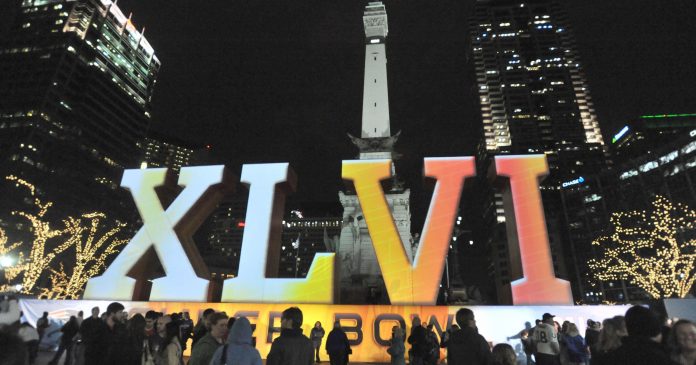 Buy Photo
Buy Photo
A huge crowd gathered on Monument Circle to watch the imagery and lights projected onto the Super Bowl XLVI Roman numerals in front of the Soldiers and Sailors Monument. (Photo: Joe Vitti / The Star)
Indianapolis was full of hot air as the Giants and Patriots packed up their bags and hustled out of Indianapolis after the Super Bowl in 2012.
Full of hot air — it hit 49 degrees on game day, Feb. 5.
Full of hot air — in the days leading up to the title game the temperatures were 58, 54 and 53 degrees.
Full of hot air — bragging rights.
The city, dubbed a “cold weather” risk when leaders put in Indianapolis’ bid for Super Bowl XLVI, had pulled it off. Admittedly, the biggest player in Indy’s victory was out of its control.
Proof of that is rearing its bitter, cold head with forecasters warning of record-breaking low temperatures: -8 degrees Tuesday night and a windchill that could dive to 40 below zero.
Indy’s warm breezes and sunny skies, just right for a light jacket in 2012, could easily have been dangerously cold — what the city is expecting this Super Bowl week, seven years later.
Indianapolis weather: Record-breaking cold temperatures Tuesday night
SUBSCRIBE:Stay inside, buy 3 months of IndyStar for $3, read by the fire
It happened last year in Minneapolis, the coldest high temperature for a dome game in the Super Bowl’s 52 years. Outside of U.S. Bank Stadium, the temperature at kickoff was 2 degrees with a wind chill of -14.
Similar, albeit even colder, “arctic air has moved into central Indiana,” the Weather Service said in a special statement issued 3:30 a.m. Tuesday.
So, what if the weather had been freaky cold — like this — when Indy hosted the Super Bowl in 2012?
A different scene
The human hamster wheel on Georgia Street, which saw people breaking into a sweat as they scurried inside, would have frozen in its tracks.
The walking tacos and domestic beers fans were downing in the Super Bowl Village would have been replaced with hot cocoa and steaming soup.The zip line winging people along Capitol Street and the concerts outside would have moved to plan B.
The NFL Network set where anchors showcased the city would have been torn down and hurriedly revamped inside the convention center.
The men wearing khaki shorts walking into Lucas Oil Stadium on game day would have had ice whiskers enmeshed in their beards.
Instead, fans in the village were photographing — not using— the portable heating units that looked like metal pyramids with flames burning inside.
“With temperatures in the 50s, the heating units were more decorative than functional,” a “New York Times” reporter wrote, “though dozens of patrons walked up and placed hands on them, confirmed ‘fire hot,’ and moved on all the more educated by the experience.”
Despite the weather luck, Indianapolis Colts chief operating officer Pete Ward is sure the city would have had just as great a success even with a frigid wind chill. He pointed to the compact, walkable layout of the city with its buildings, restaurants and hotels all connected.
“Honestly … Indy is so perfect for the Super Bowl in winter, since our downtown is nearly impervious to weather for a major event like this,” he said. “I think it would have been great, regardless of weather.”
But those who enjoy the outdoors appreciated that even though some days dipped into the 40s, with morning temperatures in the 30s, bitter cold stayed away.
Indy’s Super Bowl host committee chairman Mark Miles always credited that to committee CEO Allison Melangton.
“I am a very prayerful person. I prayed a lot over those four years (of planning) that we would have safe weather,” Melangton said. “I didn’t want to pray for things that were selfish, like good weather, so I prayed for safe weather.”
What’s brewing in Indy tonight most definitely would not be safe. And Melangton is grateful this wasn’t what the fans faced seven years ago.
The risk was real
Game time temperature that Super Bowl day in Indianapolis was 44 degrees outdoors.
“We all remember the Super Bowl as having the best weather ever,” Melangton said. “We remember the best parts, like the day the Super Bowl Village opened; it was gorgeous out, sunny, in the 50s, just beautiful.”
In reality, there were some chilly days. At least three times wind and cold shut down the zip line in the 10 days leading up to the Super Bowl. Melangton remembers being in the village one day, freezing, bundled up in a coat and scarf. The day before the Super Bowl, the high was just 41.
And the morning of the game, Melangton sat in a control center, worried about a snow storm that looked like it might hit the city. The storm was moving across Illinois, dropping about two inches of snow.
“Enough snow that we had to make a call,” she said. “We had to think about a re-shift of volunteers, adjusting plans. Most of my Super Bowl day morning was spent doing that.”
The storm ended up settling further north in Indiana and never dropped a flake on Indianapolis.
Still, Melangton had visions in her head of what she had seen the year before during the Super Bowl in Dallas. Five inches of snow had coated the city — which has an average February high of 63 degrees — and hundreds of flights were canceled just two days before Pittsburgh took on Green Bay.
Six private contractors working to get the Cowboys’ stadium ready ahead of the game were sent to the hospital after injuring themselves on the ice.
The ice was the worst part, said Melangton, who was there with the committee to take notes.
“It was sheer ice everywhere. You couldn’t even walk on the sidewalk,” she said. “I felt so sorry for the Dallas people. They had a great organizing committee.”
Melangton said seeing all of that happen in real time helped Indy’s committee tweak its own weather plan. A full binder held page after page after page of that master plan.
If it got too cold, volunteer shifts would be reduced from four hours to two hours. Back-up volunteers would be called to fill the openings. Bands had been asked if it was too cold for an outdoor concert whether they had to leave the city immediately of if they could stay for another day.
“We had a domino plan,” she said. “We had scenario A then B, C, D.” The latter three were never used.
There were street plans crafted and alternate routes drawn should weather wreak havoc on travel. There were warming stations everywhere. There were inside activities.
At the end of it all, after the Giants defeated the Patriots and those 70,000 fans went their separate ways, the NFL had a question for Indianapolis.
Could it have the city’s weather preparedness plan to show other host sites?
“Of course,” Melangton said, “that is the greatest compliment.”
Weather for 52 Super Bowl games
>21 had a trace or more of rain, 40.4 percent
>3 had snow on game day: Silverdome in Pontiac, Mich., 1982; Ford Field, Detroit, 2006; and U.S. Bank Stadium, Minneapolis, 2018
>1 was played during an ice storm: Georgia Dome in Atlanta, 2000
>Warmest high temperature on game day was 82 degrees: Tie between Memorial Coliseum in 1973 and Qualcomm Stadium in San Diego in 2003
>Coldest high temperature for a dome game was 9 degrees: U.S. Bank Stadium, Minneapolis, 2018. The temperature outside at kickoff was 2 degrees with a wind chill of -14.
>Coldest high temperature for non-dome game was 43 degrees: Tulane Stadium in New Orleans, 1972
>Wettest game had .92 inches: Dolphin Stadium, Miami Gardens, Fla., 2007 (in which the Colts defeated the Bears).
Source: The Southeast Regional Climate Center at the University of North Carolina
Follow IndyStar sports reporter Dana Benbow on Twitter: @DanaBenbow. E-mail her at [email protected].





































